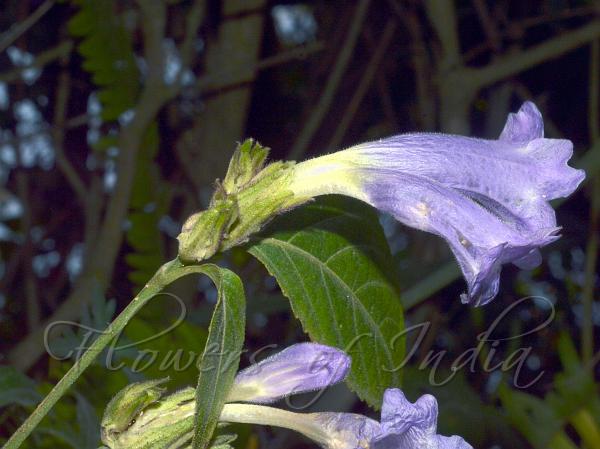|
| Two-Headed Coneflower |
|

|

| File size | 755486 |
| Original date | 11/26/19 12:55 PM |
| Resolution | 0 x 0 |
| Flash | Flash fired, return detected |
| Focal length | 60.0mm |
| Exposure time | 1/200s |
| Aperture | 25.0 |
| Focus Distance | |
| Metering Mode | Multi-segment |
| Camera make | NIKON CORPORATION |
| Camera model | NIKON D3200 |
| Sensor type | OneChipColorArea |
|
|
|
|
Photo: |
Botanical name: Strobilanthes capitata Family: Acanthaceae (Acanthus family)
Synonyms: Goldfussia capitata, Ruellia biceps, Strobilanthes biceps
Synonyms: Goldfussia capitata, Ruellia biceps, Strobilanthes biceps
Two-Headed Coneflower is a subshrub to perennial herb,
up to 1 m tall, much branched, with variable leaves. Flowers are borne
in leaf-axils, in stalked heads, often two, ovoid to ellipsoid, 1.5-2 x
1-3 cm, 1-3 per axil, sometimes forming a panicle of heads with reduced
leaves; flower-cluster-stalk 1-6 cm. Flower blue, 4.3-5.5 cm, straight,
outside thinly hairy, inside hairless; tube basally cylindric and
narrow for about 1.5 cm then gradually widened to about 1.5 cm at
mouth; lobes oblong, about 5 x 4 mm. Stamens 4, not protruding.
Sepal-cup is pale green, about 1.2 cm, enlarging to about 2 cm in
fruit, 5-lobed almost to base; sepals linear-inverted-lanceshaped,
margin fringed with hairs. Stems are prostrate to rising up, hairy,
becoming hairless. Leaf-stalk is 1-3 cm; leaf blade lanceshaped,
elliptic-ovate, or elliptic, 4-14 x 1.5-9 cm, below velvet-hairy along
veins but often becoming hairless, above sparsely hairy and with
numerous protrusions, secondary veins 6 or 7 on each side of midvein,
base narrowed and oblique, margin sawtoothed, tip tapering. Capsule
oblong, 1.4-2 cm, apical half gland-tipped hairy, 4-seeded. Two-Headed
Coneflower is found in forests in Bhutan, NE India, Myanmar, Nepal and
China, at altitudes of 900-1700 m. Flowering: September-February.
| Identification credit: John Wood | Photographed in Kalimpong, West Bengal. |
• Is this flower misidentified? If yes,